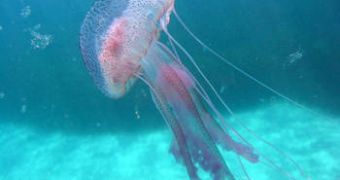These past few days, stinging jellyfish have continued to gather in the waters next to Spain's beaches, causing tourists and locals to worry about the threats they pose to public health.
Moreover, questions are raised with respect to how this invasion will ultimately impact on the incomes these regions supposedly make from tourism.
Thus, hotel owners and other people running similar businesses in the area now see themselves forced to spend considerable amounts of money on operations aimed at taking these marine creatures out of the water.
The goal is that of once again making it safe for tourists to swim in these waters.
According to marine biologists, the jellyfish species that now has pretty much taken over the Malaga coast of southern Spain is the Pelagia Noctiluca, most commonly known as the 'mauve stinger.'
Interestingly enough, this boost in the mauve stinger population is linked by several environmental scientists and even by high officials to the fact that, over the past few years, Spain's waters have witnessed an increase in the frequency of fishing activities, which means that it is quite likely that humans have left these jellyfish without their natural predators.
Others claim that changing wind and oceanic currents are what drove these animals so close to Spain's beaches in such larger numbers.
Daily Mail informs us that, in spite of the safety precautions taken by the country's beach administration and government, nearly 1,000 people got stung and were forced to ask for medical treatment to help ease the pain.
Although this unfortunate situation has been going on for quite some time now, with the jellyfish coming and going as they see fit, it seems that all attempts to safeguard Spain's waters and keep tourists out of harm's way are bound to end in failure.
From where we stand, it is indeed quite likely that this jellyfish invasion has been caused by overfishing in the area.
However, should this be proven to be the underlying cause, it is also safe to assume that, by better managing existing fish stocks, similar situations can be prevented from occurring again in the future.
The video below offers you a glimpse into what is presently happening in the waters close to Spain's beaches.

 14 DAY TRIAL //
14 DAY TRIAL // 